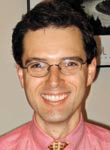Article
CK corrects hyperopia temporarily in study
Las Vegas-Conductive keratoplasty (CK) has been shown to be a safe procedure to correct hyperopia; however, over the long term, the effects of the procedure regress substantially, and patients should be advised that the treatment may not be permanent, according to Jason S. Ehrlich, MD.

"CK had very promising 1-year results for the correction of hyperopia as originally reported in Ophthalmology (McDonald et al. 2002;109:637-649) in a study of 355 eyes at 13 centers nationally that resulted in the FDA approval of the procedure," Dr. Ehrlich explained at the American Academy of Ophthalmology annual meeting.
Dr. Ehrlich and Edward Manche, MD, have been following the cohort of 25 eyes of 14 patients from the original study who were enrolled at Stanford University, Stanford, CA. The goal of the single-center, prospective study was to evaluate the safety, efficacy, and stability of CK for the treatment of mild-to-moderate hyperopia 36 months or longer after the procedure was performed.
The mean age at the time of enrollment in the study was 55 years. All patients had mild-to-moderate hyperopia with +0.75 to +3.0 D of spherical hyperopia and 0.75 D or less of cylinder.
In 2003, when 18 of the original 25 eyes had completed 24 months of follow-up, 64% of the patients had 20/20 UCVA and 95% had 20/40 or better UCVA. The preoperative mean spherical equivalent (SE) in these eyes was 1.64 D; at 24 months the mean SE was 0.48 D, which was a 29% regression from plano, he reported.
Dr. Ehrlich has followed 16 eyes of nine patients for 36 months or longer (mean, 73.6 months; range, 44 to 90 months), which, he noted, is the longest follow-up for CK to the best of his knowledge.
"The cohort of 16 eyes had a preoperative mean manifest refractive SE of +1.49 D. Following the procedure, the patients' vision was plano, and 24 months postoperatively, the group had a mean value of +0.6 D. We observed an almost linear pattern of regression of the CK treatment effect; at just over 6 years of follow-up, the mean SE of +1.43 D compared with the preoperative value of +1.49 D," he stated.
Regarding safety, at the last follow-up examination, 20% of the patients had 20/20 or better uncorrected vision, 42% had 20/30 or better vision, and 58% had 20/40 or worse vision, according to Dr. Ehrlich.
"These results reflect that most of the patients were again hyperopic and that four of the patients had developed cata-racts of varying severity," he said.
All of the eyes were refracted to at least 20/40, and the induced cylinder did not exceed 0.75 D. No eyes underwent a re-treatment procedure.
When the preliminary CK findings were presented, the question arose about whether the results represent only hyperopic progression.
"I could not answer that question because most of the eyes in the study were treated. There was one untreated eye of a 55-year-old woman that was followed that had a preoperative SE of +1.55 D, and 7 years later the untreated eye had gained 0.5 D of hyperopia," he said.
Newsletter
Don’t miss out—get Ophthalmology Times updates on the latest clinical advancements and expert interviews, straight to your inbox.




